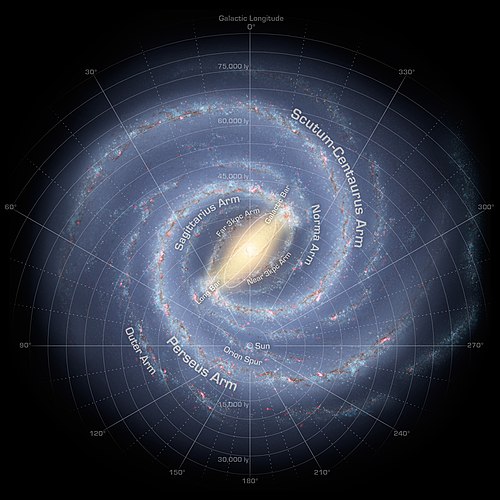 |
| By NASA/JPL-Caltech/R. Hurt[see page for license], via Wikimedia Commons; in the Public Domain |
It's the Year 1982.
Twenty Years earlier, the Illithids were defeated in a major Interstellar War against the Nations and the Powers of World War Two. The Allies and the Axis joined together to fight the Illithids. Using FTL capability given them by the Eldar, the Earthers fought a major campaign to keep their independence and right to live.
The Earthlings defeated the Illithids at the Battle of Orion in 1962, forcing them to withdraw their imperial interests out of the Orion Spur. The Illithids still have a far reaching empire: in the outer arm, the Perseus Arm, the Norma Arm, and the Scutum-Centaurus Arm of the Milky Way Galaxy.
Mankind has settled the galaxy some forty light years beyond Sol. Each Nation, except the USSR, formed their own stellar nation and their citizens raced to these new nations to start new lives among the territory that the Earthers conquered from the Illithids. But the Illithids are still out there, biding their time to plot revenge.
 | |||
| This image of the "Mind flayer" creature (concepted by TSR Inc. and Wizards of the Coast) is a from-scratch fan drawing. |
The Illithids were utterly defeated, but there are planets within the Orion Spur where some are still rumored to exist. The defeat did not come easily, but victory meant that the humans had new worlds to settle that were under Illithid Domination. And in the far Frontier, skirmishes between Illithids and Earthers are uncommon.
TECHNOLOGY OF THE EARTHERS
The Technology of the Earthers are simple, it's rivets and steel. While the Illithids use organic hulls on their space ships, the Earthers use strong Fullerine hulls. While the Eldar use wood, the Scro also depend on metal.
Space Drives
Human Technology depend on a Plasma Ion Propulsion drive for space -- which is similar to a fusion reactor drive, but plasma is used to foster the fusion process and the resultant ions are forced out of the nozzles. While in air, propulsion is based on a reactionless electromagnetic gravity drive. The Earther ships are able to produce electromagnetic fields around their ship that causes the ship to counter gravity and lift themselves up.
Humans depend on two star drives: the Plasma Slipstream Drive and the Fold Space Drive. The Plasma Slipstream Drive creates a Birkland Current around the ship and slips it into Faster Than Light travel.
 |
| Plasma Slipstream, in action. (From Stargate Universe) |
Drive Speed:
The new generation of Plasma Slipstream Drives allows ships to go at 7 parsecs a day.; this pretty much means that a ship traveling from Earth to Alpha Centauri at about 4.5 hours, to Canopus (which is 30 parsecs) about 4 days of travel; and Across the Galactic Arm, which is 2,000 parsecs: about 9 months. It takes 4 years to reach the Plasma confluence at the Galactic Core -- a distance of 10,000 parsecs. The Fold Drive system can carry ships up to a maximum of 50 light years per use. Most people prefer to use the Plasma Slipstream FTL if they can help it. The first generation Fold System is very temperamental and unreliable.
Fuel
Earther Ships rely on Plasma Fusion Generators to generate ion thrust and electrical power for the ship. However, the Zero Point Energy Converter is still experimental, as it would convert Zero Point Energy into electrical power and propulsion power. The fuel capacity for Plasma Fusion allows a ship to have a range of 20 parsecs non-stop.
 |
| Star Fashion, by myself. |
FTL Astrogation
FTL Astrogation is Complex and 3-Dimensional. The course must take into account the gravitational fields of intervening suns and star drift. A reliable course (Astrogation, Medium) can only be computed if the Astrogator has complete information about the system.
Communications
The communications of the galaxy depends on FTL communication via a tachyon network. While frontier planets depends on courier ships; planets closer to Sol uses the Tachyon network. Courier ships use Fold Systems to get from place to place, though, delivering the news.
Computers and Cybernetics
IN 1982, the Intergrated Circuit is still in its infancy. Computers have the power of a Apple IIe or a TRS-80 (pronounced trash 80) or an IBM computer with only 128 kilobytes of memory. Calculations and programming are done by Machine Language (COBOL), C, and Microsoft BASIC. Spreadsheets and Databases keep the computer banks informed. However, most ships have mainframes that carry 10 GBs of storage. Given the computer's level of evolution, however, Energy Matter Teleporation by machine is necessarily impossible.
Gravity Manipulation!
Gravity onboard ship is achieved by using electricity to produce the necessary Gravity aboard ship. Electricity is 10 to the 39th power much more powerful than gravity. Conversely, a ship is capable of generating powerful electromagnetic fields to counteract the effects of gravity, in order to lift itself into space.
Next Post: RACES!
No comments:
Post a Comment